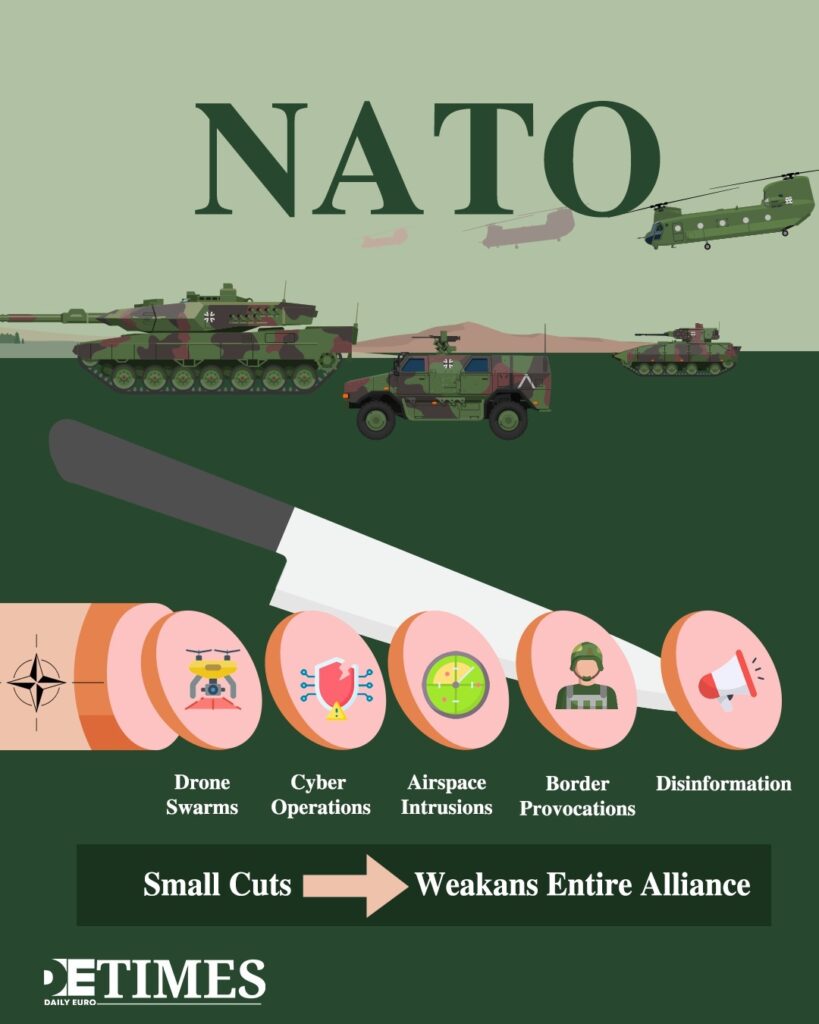Polish airspace was violated by at least 19 Russian drones overnight on 9 September, sending NATO fighter jets scrambling to shoot down several of the unmanned aircraft.
It was the first time since Russia’s 2022 invasion of Ukraine that Moscow’s military hardware had directly breached NATO territory.
Poland called the incident an “act of aggression” and invoked NATO’s Article 4, which requires an alliance meeting whenever a member faces a security threat.
Alliance Tested by Airspace Violations
NATO fighter jets shot down multiple Russian drones that violated Polish airspace during an attack on neighboring Ukraine, as the military alliance denounced Moscow for “absolutely dangerous” behavior.
Several allies pitched in alongside Poland, including Polish F16s, Dutch F35s, Italian AWACS aircraft, and NATO multinational forces. The response worked like clockwork.
Yet the alliance's careful response reveals a troubling reality. Despite the clear breach of territory, NATO stopped short of invoking Article 5: the collective defense clause.
Since Poland is a NATO member, a drone attack on its soil could trigger Article 5 of the NATO treaty, which says that an “armed attack” against one or more members in Europe or North America should be considered an attack against all.
Instead, the alliance chose diplomacy over military escalation.
Gulf Strike Strains Western Partnerships
Meanwhile, another crack appeared in Western alliances thousands of kilometers away. Israeli forces attacked Hamas targets in Qatar’s capital Doha on 9 September, with 15 Israeli jets hitting residential buildings.
The White House said the strike, which went after Hamas leaders and killed six people, "does not advance Israel or America's goals," even though Qatar serves as a major non-NATO ally and hosts a US military base.
Israeli commentators openly speculated that Türkiye could be next, suggesting the NATO member “is not the safe haven Hamas believes it to be.”
Türkiye maintains strong partnerships with Qatar. Turkish officials condemned the Qatar strike but stopped short of threatening retaliation.

Hybrid Warfare’s Slow Erosion
Airspace intrusion represents classic hybrid warfare tactics designed to test alliance resolve without triggering full-scale conflict.
Moscow accomplishes several things through such needle-prick operations. They gauge how NATO responds, create precedent for future violations, and spark internal alliance debates about what constitutes an appropriate reaction.
Ukrainian President Volodymyr Zelenskyy called the episode "an extremely dangerous precedent for Europe," while EU Defense Commissioner Andrius Kubilius called for developing a "drone wall" along the eastern flank. The incident happened during a massive Russian assault on Ukrainian infrastructure.
Drone spillover into NATO territory seems increasingly likely as the war intensifies. Each small violation that goes unanswered chips away at deterrence credibility. NATO faces a salami-slicing problem where individual provocations seem too small for major responses, yet together they weaken alliance foundations.
The pattern echoes how territorial water disputes gradually shift maritime boundaries through persistent low-level intrusions.
Article 5’s Evolving Meaning
The Poland drone incident exposes fundamental questions about NATO’s mutual defense guarantee in modern conflict. Experts see this as a test of NATO’s unity, with potential implications for European peacekeeping in Ukraine and US policy on Russia.
Traditional interpretations of Article 5 assumed large-scale conventional attacks, not drone swarms or cyber operations. NATO’s reluctance to invoke collective defense for unmanned systems creates precedent for future gray-zone operations.
If nineteen military drones crossing sovereign airspace don’t constitute an armed attack, what does?
The alliance risks establishing that only manned aircraft or ground forces trigger mutual defense obligations.
Hybrid warfare exploits the gaps between peace and war, using techniques that fall below traditional escalation thresholds. NATO’s current structure struggles with responses proportional to ambiguous provocations. Evidently, traditional deterrence models based on massive retaliation lose their punch against gradual provocations.
Europe needs fresh thinking about collective security in an era of hybrid threats and multipolar competition. The EU’s proposed “drone wall” along its eastern borders represents one adaptation to new security requirements.
Keep up with Daily Euro Times for more updates!
Read also:
Defence: NATO’s New Strategy in Eastern Europe
Freeriders: Spain and Italy Opt Out of NATO Hike
Peacemaker No More: Austria Ditches Neutrality for NATO






